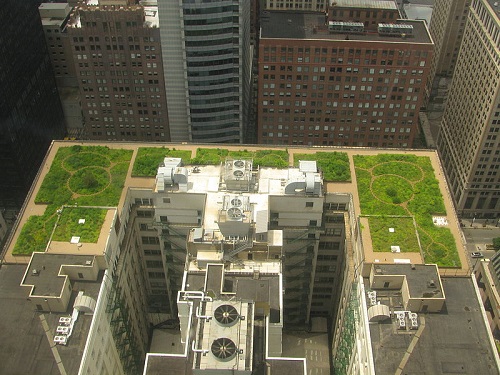Thanks to Dino Green for this guest post. He is an engineer, a technology fan and an advocate of environmental sustainability.
Green buildings incorporate green, environmentally friendly building elements such as being energy efficient or incorporating green technologies such as solar photovoltaic panels. By green-building-roofs, we refer to the concept of planting a garden on the roof of a building, thus making it literally green with vegetation. At a closer look, it turns out that green roofs can help improve the environmental behaviour of a building by both improving its energy performance and boosting the performance of roof-mounted solar panels.

Green building roof
Planting a green garden on the roof of a building can help increase its energy performance; the vegetation infrastructure of soil, insulating and waterproof material and the vegetation itself, form an effective insulation layer on the roof of the building. Considering that the roof constitutes the primary source of energy waste in a building it is evident that planting a garden on the roof will effectively reduce unwanted energy gains from radiation in summer and reduce internal heat losses in winter – see green buildings: Rational solutions.
Apart from the direct energy efficiency benefits to the building, green roofs, when applied at the community level, can have additional benefits in the micro-climate of urban areas. Empirical data suggests that a community of green roof-top-buildings can help combat the accumulation of heat that builds up in urban areas, know as heat island effect. Consequently, by replacing the concrete or general conventional building roofs with green, vegetated rooftops we can benefit in dual ways: directly by increasing the energy efficiency of buildings and indirectly by creating a cooling effect in the hot micro-climates of urban areas.
Regarding the extra cost for planting a garden on the roof of a building, it seems that it is justifiable and the investment economically sustainable. Research results from Green Roof Valuation show that green roofs, when compared to conventional building roofs, exhibit a lower investment cost when discounted in Net Present Values (NPV) over a period of 30-40 years.
In fact, the extra initial cost for planting a building’s roof can be recovered through energy savings from improved energy behaviour of the building. In addition, green roofs offer extra benefits both environmental and economical by improving air quality in urban areas and reducing harmful emissions into the atmosphere. For example, a green, vegetated, roof of approximately 2000 sq.m. can yield savings of about $1,000-$3,000. Therefore, green roofs in urban areas can help us improve environmental, economic and aesthetic performance of our buildings.
Green roofs boost performance of roof mounted solar panels
Apart from the above-mentioned advantages, green roofs can yield additional benefits especially in cases of roof mounted photovoltaic panels. The extra benefit comes in the form of increased solar panel efficiency which translates in more generated electricity (kwh), thus more income from on-grid FIT’s schemes. The reason for this lies in the operating temperature requirements of solar panels. Simply put, a solar panel system on a concrete roof top will perform less than the same solar panel system if placed on a green vegetated roof top.
Research suggests that planting a garden on a roof top with photovoltaic panels will improve solar panel performance by approximately 15 percent. This improvement is mainly due to the lower temperatures maintained by the roof garden; as already illustrated, green roofs create a cooling effect which is significantly evident in urban areas. Through this cooling effect, the temperature around roof-mounted solar panels is reduced, thus giving them a boost of performance.
That is why solar panels in urban areas, by default, have lower performance than respective solar panel systems installed in open rural areas. The cooling effect in rural areas has been a significant factor for better photovoltaic performance. This acclamation can be well documented by looking at solar panel manufacturers’ specifications, amongst which they quote optimal operating temperatures and solar panel temperature coefficients. Of course, the boosting effect can vary depending on location and climatic conditions. In general, the boost effect is more in hot climates where temperatures are well above optimum conditions of photovoltaic cells thus affect negatively the performance of photovoltaic panels.
Consequently, it becomes evident that by combining green technology, such as roof mounted photovoltaic panels, with green, vegetated, roof tops in buildings, we can create synergies highly beneficial to the environment, the economy and to the architectural design of urban areas.
Author: Dino Green is an engineer; a technology fan and an advocate of environmental sustainability on his personal blog. He also offers a focus area concerning solar energy facts.
Image:http://en.wikipedia.org/wiki/File:20080708_Chicago_City_Hall_Green_Roof.JPG, Tonythetiger
[source: http://feeds.importantmedia.org/~r/IM-greenbuildingelements/~3/m0txwvb2aTQ/]

Leave a Reply
You must be logged in to post a comment.